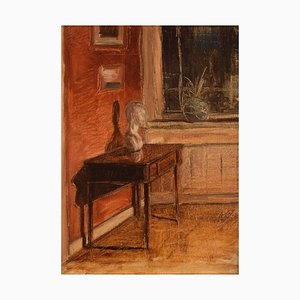
Axel Johannes Salto (1889-1961) was a Danish painter, graphic designer, illustrator, and ceramic artist, who was primarily known for his sensuous and earthy stoneware. Breaking away from his contemporaries to design pieces that were highly unconventional, Salto’s signature designs resisted functionalism, and anticipated later sculptural trends in mid-century European and North American ceramics.
Born in 1889 in Copenhagen, Salto studied at the Royal Danish Academy of Fine Arts from 1909 to 1914. Inspired by his undergraduate studies, Salto’s early work subtly reflected certain iconography from classical languages and Greek mythology, as well as the visual motifs of Art Deco. His work had a penchant to oppose functionalist aesthetics in favor for more sculptural and botanical forms. His style evolved over the course of his career, from heavy and somber woodcuts to gracefully turned stoneware pieces that captured the ephemeral qualities of life and the fertile forms of nature. To achieve this, Salto used relief patterns and ornamentations on his pieces as an instrument for various glazing techniques.
In 1916, Salto visited Paris and met Pablo Picasso and Henri Matisse. As an avid painter himself, the meeting had considerable impact on Salto and his artistic ambitions. Salto returned to Denmark and established the influential albeit short-lived art journal, The Blade. As editor and contributor, Salto’s aim was to spark a conversation of Modernist art and theory in Northern Europe. Published from 1917 until 1919, contributors included Otto Gelsted (1888-1968), Poul Henningsen (1894-1967), and Harald Giersing (1881-1927), with original artwork by Vilhelm Lundstrøm (1893-1950), Olaf Rude (1886-1957), and William Scharff (1886-1959).
In 1921, Salto formed a group of experimental artists who lived and worked together in Paris. The group, which consisted of Svend Johansen (1890-1970), Vilhelm Lundstrøm, and Karl Larsen, exhibited their art regularly in Paris throughout the 1920s. From 1923 until 1929, Salto worked with Danish porcelain manufacturer Bing & Grondahl in Copenhagen, receiving a silver medal for pieces exhibited at the Paris World Fair in 1925. During the 1930s, Salto joined the porcelain factory Royal Copenhagen, where he experimented with the development of glazes and bright colors, such as turquoise.
Unlike his contemporaries who were influenced by Japanese and Chinese ceramic traditions, Salto’s best known pieces combine uninhibited shapes with unexpected colors and glazes. His pieces are often grouped into three categories: budding, sprouting, and fluted; as each expresses movement and growth through the tactile forms that imitate gourds, seed pods, buds, and ripe fruits.
Salto received many awards and accolades including the Paris World Exhibition Grand Prix in 1937, the Eckersberg Medal in 1938, the Milan Triennial Grand Prix in 1951, and the Prince Eugen Medal in 1959. Although Salto is most known for his ceramic pieces, he was an active painter throught his life; illustrating several children's stories and poetry, as well as designing textiles for the Danish manufacturer L.F. Foght.
Salto passed away in 1961 in Frederiksberg.

